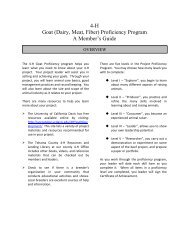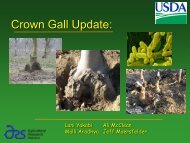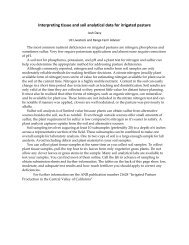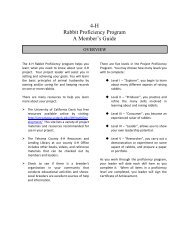Phytophthora Root and Crown Rot Disease - Tehama County
Phytophthora Root and Crown Rot Disease - Tehama County
Phytophthora Root and Crown Rot Disease - Tehama County
- No tags were found...
Create successful ePaper yourself
Turn your PDF publications into a flip-book with our unique Google optimized e-Paper software.
Soilborne <strong>Disease</strong> Challenges:I. <strong>Phytophthora</strong> (<strong>and</strong> Other!!) <strong>Crown</strong> <strong>and</strong> <strong>Root</strong> <strong>Rot</strong>s --Where are We?<strong>Tehama</strong> <strong>County</strong> Walnut Day20 January 2012Greg Browne,Ravi Bhat, Leigh Schmidt,<strong>and</strong> UCCE Farm Advisors
Typical symptoms,<strong>Phytophthora</strong> crown <strong>and</strong> root rots
More symptoms,<strong>Phytophthora</strong> cankers
More symptoms, but not apparently caused by <strong>Phytophthora</strong>• Symptoms• Spatial dist.• Vlach vs. RX1• Rstk genetics?• Symptoms• New develop.
Orchard affected bythe oak root fungus,Armillaria
High water table <strong>and</strong> flooding damage, Paradox <strong>and</strong> NCB rootstocks
High water table <strong>and</strong> flooding damage, Paradox <strong>and</strong> NCB rootstocks
<strong>Phytophthora</strong>,“Plant Destroyer”Oospores(long-term persistence,sexual reproduction)Sporangia(rapid spread, asexualreproduction)
More pictures, <strong>Phytophthora</strong>Photos: Wharton <strong>and</strong> Kirk, MSUPhoto: Sullivan, NC StateZoospores on rootOospore, note thick wallSporangium,note zoospores,(one swimming out)Zoosporedrawing,note flagella
Role of free water in root <strong>and</strong> crowninfection by <strong>Phytophthora</strong>(Soil) water saturation favors:• sporangia production• zoospore production• zoospore dispersal• zoospore attraction to roots
Role of “surface water” in long-distance spread of <strong>Phytophthora</strong>LakesideDitch
Isolation <strong>and</strong> rDNA-based id. of <strong>Phytophthora</strong> spp. inSurface Sources of Irrigation Water in Kings <strong>County</strong>Detected:•<strong>Phytophthora</strong> citricola•P. citrophthora•P. cryptogea•P. gonapodyides•<strong>Phytophthora</strong> sp. (unid.)•Several Pythium spp.
Inoculum of <strong>Phytophthora</strong> spp. can be blown uponto almond trees during harvestInfested soil can transport<strong>Phytophthora</strong> onto trees &between orchardsPhoto-Bruce Lampinen
How to prevent <strong>and</strong> manage??
Approaches to control, <strong>Phytophthora</strong>1. Find <strong>and</strong> use rootstocks with genetic resistance(VLR)(MR)ck cit cinNorthern California black(Juglans hindsii)<strong>and</strong> English (J. regia)ck cit cit cinParadox hybrid(J. hindsii, <strong>and</strong> others, x regia)(VHR)Chinese wingnut(Pterocarya stenoptera)ckcitcin
Seedling evaluation program,resistance to <strong>Phytophthora</strong>, 1997-99
20012004a2004b20062007a2007b2008a2008b200920102007a2008a2008b20092010OverviewClonal evaluationsof resistance, 2001-10:• >40 clonal hybrid selections• Include elites fromseedlings screens with<strong>Phytophthora</strong>,Agrobacterium,Pratylenchus, CLRV; alsocontrolled crosses• All hybrids w/ J. regia aspaternal parent• All hybrids, simple <strong>and</strong>complex, w/ black walnutmaternal parents• St<strong>and</strong>ards AX1, NCB, &Chinese WN•RX1 is a product*P. citricola P. cinnamomiRstk.Maternal parent CloneJuglans ailantifolia DAR + + + +J. californica AX1 + + + + + + + + + + + + + + +J. californica AX2 + + + + + + +J. californica AX3 + + + +J. hindsii GZ1 + + + +J. hindsii GZ2 + + + + + + + +J. hindsii GZ3 + + + + + +J. hindsii JX1 + + + + + +J. hindsii JX2 + + + + +J. hindsii J1Acont + + + +J. hindsii J21cont + +J. hindsii JJ1Dcont + +J. hindsii PX1 + + + + + + + + + +J. hindsii RR1cont + +J. hindsii RR4cont + + + + + +J. hindsii bur + +J. hindsii UZ1 + + + + + +J. hindsii UZ2 + + + + + +J. hindsii UZ229 + + + +J. hindsii VX211 + + + + + + + + + + + + + +J. hindsii XZ1 + +J. hindsii Vlach + + + + + + + + + +J. hindsii 84-121 +J. microcarpa RX1 + + + + + + + + + + + + + + +J. nigra RW2 + +J. nigra CW1 + + + + + +J. californica x J. nigra UX1 + + + + + + +J. californica x J. nigra UX2 + + + + + + + + + + +J. californica x J. nigra UX022 + +(J.major x J.hindsii) x J.nigra AZ1 + + +(J.major x J.hindsii) x J.nigra AZ2 + + + + +(J.major x J.hindsii) x J.nigra AZ3 + + + +(J.major x J.hindsii) x J.nigra AZ025 + + + +(J.major x J.hindsii) x J.nigra MW1 + + + + + + + +(J.major x J.hindsii) x J.nigra NZ1 + + + +(J. hindsii x J. regia) WIP2 + + + + + +(J. hindsii x J. regia) WIP3 + + + + + + + + + +(J. hindsii x J. regia) WIP4 + + + +(J. hindsii x J. regia) WIP6 + + + +Pterocarya stenoptera* Ch. Wn. + + + + + + + + + + +J. hindsii * NCB + + + + + + + + + + + +J. regia* CR + + + +J. regia* Tulare + +J. regia* Howard + +
2001-2010 summary, large-plant evaluations,crown rot variable, P. citricolaMean deviation from AX1,percent crown length rotted40200-20-40-60DARAX1AX2AX3GZ1GZ2GZ3J1AcontJX1JX2PX1RR4contUZ1UZ2UZ229VX211VlachRX1CW1UX022UX1UX2AZ025AZ1AZ2AZ3MW1NZ1WIP2WIP3WIP4WIP6CRNCBCh.Wn.**
2001-2010 summary, large-plant evaluations,crown rot variable, P. cinnamomiMean deviation from AX1,percent crown length rotted40200-20-40-60DARAX1AX2AX3GZ2GZ3J1AcontJX1PX1RR4contUZ1UZ2UZ229VX211VlachRX1* *CW1UX1AZ025UX2MW1WIP2WIP3WIP4WIP6CRNCBCh.Wn.
Field testing of RX1 rootstock,Joe Grant, UCCE Farm Advisor7-15-2003 9-16-2011Orchard area infested with <strong>Phytophthora</strong> cinnamomi
Field validation of RX1 rootstock,Joe Grant, UCCE Farm AdvisorRX1 <strong>and</strong> Paradox seedlingtrees were planted April 2010;there were 100 two-tree pairs
Field testing RX1(trees planted March 2010)Results to date*:Yr<strong>Root</strong>stockMortality(%)**2010 Pdx sdg. 0RX1 02011 Pdx. sdg. 17 (+6)RX1 0*P. cinnamomi isolatedfrom 63% of deadtrees <strong>and</strong> 40% ofpoorly growing trees.**Surviving trees grewsimilarly.Poorly growingPdx seedlingRX1
Current status, rootstock work• Promising clonal selections are available• More field experience is needed with available clones• Broader explorations are justified <strong>and</strong> underwayplant30 ml inoculumSmall-plant assay for resistance to P. cinnamomi <strong>and</strong> P. citricola
Evaluation of phosphonatetreatments for control of<strong>Phytophthora</strong>Terry Prichard’s walnut irrigation block, Davis
Design of phosphonate (Fosphite®) trial, Campbell Tract, Prichard irrig. blockNCBNCBPPPNCBPNCBNCBPNCBNCBNCBPNCBPPPNCBNCBPNCBNCBPNCBPNCBPPPNCBNCBPNCBPPNCBPNCBPNCBPPNCBNCBNCBNCBPPLegend:Foliar spray (1) Chemigations (3) Control irrigation Tree trunk 1 st P.citricolawound inoc.P.citricola+cinnmomiInfested soil
Area of necrosis (cm 2 )Efficacy of phosphonate treatments (3 qts./A),-Trees inoculated 1 month after phosphonate treatments completed-Cankers measured 3 months after inoculation35302520151050Non-inoculated <strong>Phytophthora</strong> citricolaNo phosphonate 3 chemigations 1 foliar spray 3 chemigations + 1foliar spray
Area of necrosis (cm 2 )Efficacy of phosphonate treatments (3 qts./A),-Trees inoculated 7 months after phosphonate treatments completed-Cankers measured 3 months after inoculation
Assessing poorly understood crown <strong>and</strong> root problems on Paradox(Our work involves Bob Beede, Janine Hasey, Chuck Leslie, Themis Michailides, others)“Howard Yellowing”• Symptoms• Spatial dist.• Vlach vs. RX1• Rstk genetics?“Paradox canker”• Symptoms• New develop.
More Paradox canker symptoms
Paradox canker: testing pathogenicity of isolates100Canker length (mm)806040200ControlWB-1WB-2WB-3WB-4WB-5WB-6WB-7WB-8WB-9WB-10WB-11WB-12WB-13WB-14WB-15WB-16WB-17WB-18WB-19WB-20WB-21WB-22WB-23WB-24WB-25WB-26WB-27WB-28WB-29WB-30WB-31WB-32WB-33WB-34WB-35WB-3650Results:6 of 36 isolates, WB-1,WB-7, WB-13, WB-14,WB-24, WB-34 werepathogenic; theseisolates all wereBrenaria nigrifluensCanker length (mm)403020100ControlWB-1WB-2WB-3WB-4WB-5WB-6WB-7WB-8WB-9WB-10WB-11WB-12WB-13WB-14WB-15WB-16WB-17WB-18WB-19WB-20WB-21WB-22WB-23WB-24WB-25WB-26WB-27WB-28WB-29WB-30WB-31WB-32WB-33WB-34WB-35WB-36
Some key points<strong>Phytophthora</strong> typically localized butcan be devastatingTo minimize losses from <strong>Phytophthora</strong>:• Good preparation (site selection,ripping, drainage)• Irrigate to meet ET, but avoid prolongedwater saturation (>>24 hr)• Consider new rootstock option (RX1)• Phosphonate sprays can helpThere are “new” Paradox problems towatch for.More field experience needed withParadox clones.Thank You!!










